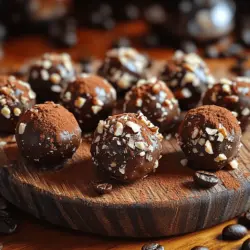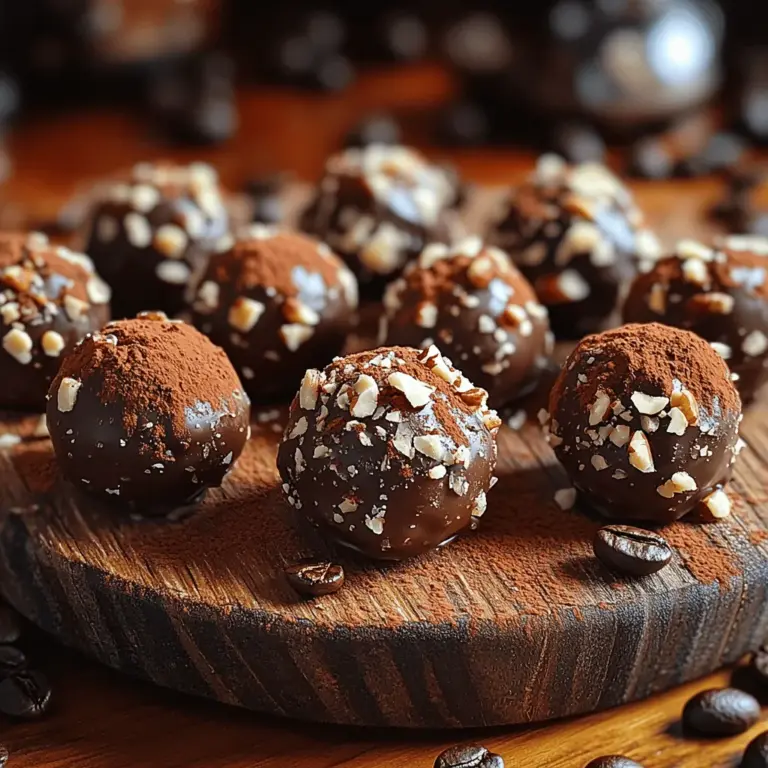Introduction
The allure of homemade treats is undeniable, and when it comes to decadent desserts, few things can match the charm of homemade chocolate truffles. These rich, bite-sized delights not only satisfy your sweet tooth but are also a testament to your culinary skills. Among the myriad of flavors one can choose from, espresso chocolate truffles stand out as a sophisticated option, marrying the boldness of coffee with the richness of chocolate. This recipe invites you to indulge in a delightful experience that is both simple and luxurious.
Espresso chocolate truffles have their roots deeply embedded in European confectionery, often associated with the artisanal chocolate-making traditions of France and Belgium. These truffles are typically made from a ganache base, which is a blend of chocolate and cream, enriched with espresso to create a harmonious balance between the robust coffee flavor and the smoothness of chocolate. The resulting treat is not only a feast for the palate but also an elegant gift, perfect for special occasions or as a personal indulgence.
One of the key elements that differentiate a mediocre truffle from an outstanding one is the quality of ingredients used. Opting for high-quality chocolate and freshly brewed espresso can significantly elevate the flavor profile of your truffles. The better the ingredients, the more satisfying the final product will be, allowing you to create a dessert that is not only delicious but also memorable.
Understanding the Basics of Chocolate Truffle Making
Before diving into the recipe, it’s essential to understand what constitutes a chocolate truffle. At its core, a truffle is a rich confection made from a ganache base, which can be flavored in countless ways. The traditional method involves creating a smooth mixture of melted chocolate and cream, which is then cooled and shaped into spheres before being coated in cocoa powder or chocolate.
The beauty of chocolate truffles lies in their versatility. While the classic chocolate truffle is a timeless favorite, adding espresso to the mix introduces a depth of flavor that tantalizes the taste buds. The interplay between the bitter notes of espresso and the sweetness of chocolate creates a balance that is undeniably satisfying.
When discussing chocolate truffles, it’s also important to differentiate between various types of chocolate. Dark chocolate, with its higher cocoa content, is typically used in truffle recipes for its intense flavor. However, milk chocolate or white chocolate can also be used for those who prefer a sweeter profile. The choice of chocolate will significantly impact the overall taste of your truffles, making it essential to select a variety that aligns with your flavor preferences.
Essential Ingredients for Espresso Chocolate Truffles
Creating the perfect espresso chocolate truffles requires a handful of essential ingredients, each playing a crucial role in achieving that coveted indulgent experience.
1. Chocolate: The star of the show, chocolate, is the foundation of your truffles. For a rich and intense flavor, high-quality dark chocolate with at least 60% cocoa content is recommended. This not only provides depth but also balances the bitterness of the espresso. For those who prefer a creamier texture, a mix of milk chocolate and dark chocolate can also work beautifully.
2. Espresso: Freshly brewed espresso is vital for infusing your truffles with that signature coffee flavor. The freshness of the espresso will ensure that the flavor is pronounced and aromatic. If you don’t have an espresso machine, strong brewed coffee can be an alternative, but the richness of espresso is unparalleled.
3. Heavy Cream: This ingredient contributes to the smoothness of the ganache. The creaminess of heavy cream helps to create a luxurious mouthfeel, making each bite melt in your mouth.
4. Butter: While optional, a touch of unsalted butter can enhance the truffles’ richness and give them a glossy finish. It’s best to use high-quality butter for optimal flavor.
5. Cocoa Powder or Coatings: To finish your truffles, you’ll need a coating. Unsweetened cocoa powder is a classic choice, providing a bitter contrast to the sweetness of the truffles. Other options include finely chopped nuts, shredded coconut, or even a layer of tempered chocolate for a more elegant touch.
Tools and Equipment for Making Espresso Chocolate Truffles
Having the right tools and equipment can make the process of making espresso chocolate truffles more manageable and enjoyable. Here are some essentials you’ll need:
– Heatproof Bowl: A heatproof bowl is crucial for melting the chocolate. Glass or metal bowls work well, as they can withstand heat from hot liquids.
– Double Boiler or Microwave: To melt the chocolate gently, you can use a double boiler setup or a microwave. Ensure you melt the chocolate slowly to prevent it from seizing.
– Spatula: A silicone or rubber spatula is perfect for mixing the ganache and scraping down the sides of your bowl.
– Spoon or Melon Baller: These tools are excellent for portioning out the ganache into uniform truffles. A small cookie scoop can also work for this purpose.
– Baking Sheet: Line a baking sheet with parchment paper to place your shaped truffles as they chill.
– Refrigerator: You’ll need a refrigerator to chill your truffles after shaping them, allowing them to firm up before coating.
– Sifter: If using cocoa powder for coating, a small sifter can help achieve a more even dusting.
Step-by-Step Guide to Making Espresso Chocolate Truffles
Now that you are familiar with the essential ingredients and tools, it’s time to embark on the delightful journey of making espresso chocolate truffles. Follow these step-by-step instructions to create rich, indulgent treats that are sure to impress:
Preparing the Ganache
1. Melt the Chocolate: Begin by finely chopping the dark chocolate and placing it in a heatproof bowl. If you’re using a double boiler, bring a pot of water to a simmer, then place the bowl over the pot, ensuring it doesn’t touch the water. Stir the chocolate gently until it is fully melted and smooth. If using a microwave, heat in 20-second intervals, stirring in between until the chocolate is melted.
2. Heat the Cream: In a small saucepan, heat the heavy cream over medium heat until it just begins to simmer. Remove it from the heat and immediately pour it over the melted chocolate. Let it sit for a minute to ensure the chocolate melts completely.
3. Add Espresso: Once the chocolate and cream are combined, add the freshly brewed espresso and mix until the ganache is smooth and glossy. If you’re using butter, add it at this stage and stir until fully incorporated.
4. Chill the Ganache: Cover the bowl with plastic wrap and place it in the refrigerator for about 1-2 hours, or until it is firm enough to scoop.
Shaping the Truffles
1. Scoop the Ganache: Once the ganache is set, use a spoon or melon baller to scoop out small portions of the mixture. Aim for about one inch in diameter for each truffle.
2. Roll into Balls: With your hands, quickly roll the ganache portions into smooth balls. It’s best to work quickly to prevent the chocolate from melting too much from the heat of your hands.
3. Chill Again: Place the shaped truffles back on the lined baking sheet and return them to the refrigerator for about 30 minutes to firm up.
Coating the Truffles
1. Prepare the Coating: While the truffles are chilling, prepare your coating. If using cocoa powder, sift it into a shallow dish. For nuts or coconut, finely chop them and place them in a bowl.
2. Coat the Truffles: Once the truffles are firm, remove them from the refrigerator. Roll each truffle in the cocoa powder or your chosen coating until fully covered.
3. Final Chill: After coating, return the truffles to the baking sheet and refrigerate once more to set completely.
As you prepare these espresso chocolate truffles, take a moment to appreciate the process and the quality of the ingredients you’re using. Each truffle you create is a blend of rich chocolate and robust espresso, culminating in a luxurious dessert that’s perfect for any occasion or simply as a treat for yourself.
Stay tuned for the next part of this article, which will delve deeper into tips for perfecting your truffles and answer common questions about chocolate truffle making.
{{image_2}}
Rolling Out the Pasta
Once your pasta dough has rested, it’s time to roll it out. Properly rolling out the dough is crucial for achieving a uniform thickness that cooks evenly. Here’s how to get started.
Techniques for Even Thickness
To ensure that your pasta has an even thickness throughout, consider these techniques:
1. Divide the Dough: Work in smaller batches. Divide your dough into four equal portions. Keeping the unused portions covered will prevent them from drying out.
2. Flour the Surface: Lightly dust your work surface and the rolling pin with flour to prevent sticking. Too much flour can dry out the pasta, so use it sparingly.
3. Roll from the Center: Begin rolling your dough from the center outwards. This technique helps maintain an even thickness and prevents the edges from becoming too thin.
4. Rotate the Dough: Periodically turn the dough a quarter turn to ensure that you achieve a round shape and even thickness.
Using a Pasta Machine vs. Rolling by Hand
When it comes to rolling out pasta, you have two primary options: using a pasta machine or rolling by hand.
– Pasta Machine: A pasta machine makes the process more straightforward and ensures consistent thickness. Start with the widest setting and gradually decrease the thickness as you pass the dough through the rollers. This method is particularly effective for making sheets of pasta for lasagna or ravioli.
– Rolling by Hand: If you don’t have a pasta machine, rolling by hand is entirely feasible. It may take more time and effort, but it’s a rewarding process. Aim for a thickness of about 1/16 inch for most pasta types.
Cutting and Shaping the Pasta
Once you’ve rolled out your dough, it’s time to cut and shape it into your desired pasta forms.
Common Pasta Shapes and Their Methods
1. Tagliatelle: To create this classic ribbon pasta, fold the rolled-out sheet into thirds and slice it into strips about 1/4 inch wide. Unravel the strips to form long strands.
2. Fettuccine: Similar to tagliatelle but slightly wider, fettuccine can be made by cutting the rolled dough into 1/2 inch strips.
3. Pappardelle: For this broader pasta, cut the dough into 1-inch strips. Pappardelle is perfect for hearty sauces.
4. Ravioli: To make stuffed pasta, place small mounds of filling on one sheet of rolled dough, leaving space between each mound. Cover with another sheet and press down around the filling to seal, then cut into squares.
5. Farfallini: Also known as bow-tie pasta, this shape can be created by cutting the dough into rectangles, pinching the middle to form a bow.
Tips for Achieving Uniform Pieces
– Use a Ruler: For precision, you can use a ruler to measure the width of your cuts, especially for dishes that require uniform pieces.
– Keep Dough Covered: To prevent drying, keep the cut pasta covered with a clean kitchen towel until you’re ready to cook it.
Cooking Fresh Pasta to Perfection
Cooking fresh pasta is a delightful experience. With these tips, you can ensure that your pasta turns out perfectly every time.
Boiling Water: The Right Temperature and Salting Tips
Start by bringing a large pot of water to a rolling boil. Use a generous amount of water to allow the pasta to move freely; about 4-6 quarts for every pound of pasta is ideal. Once boiling, add a tablespoon of salt per quart of water. This not only seasons the pasta but also enhances its flavor.
Cooking Times for Various Pasta Shapes
Fresh pasta cooks significantly faster than dried pasta. Here are approximate cooking times for various shapes:
– Thin noodles (like angel hair): 1-2 minutes
– Fettuccine or tagliatelle: 2-4 minutes
– Ravioli: 4-6 minutes
– Pappardelle: 3-5 minutes
Testing for Doneness: Al Dente Explained
To achieve that perfect al dente texture, begin tasting your pasta a minute or two before the suggested cooking time is up. Al dente means the pasta should be firm to the bite, without being hard in the center. This texture is ideal, as it allows the pasta to hold up when paired with sauces.
Sauces to Pair with Fresh Pasta
Fresh pasta is a blank canvas, ready to complement a variety of delicious sauces. Here are some classic and unique sauces that elevate your homemade pasta dishes.
Classic Sauces That Elevate Homemade Pasta
1. Simple Marinara: A quick and easy tomato sauce made with crushed tomatoes, garlic, olive oil, and fresh basil. It’s a timeless pairing for any pasta.
2. Rich Alfredo: This creamy sauce combines butter, cream, and Parmesan cheese. It’s ideal for fettuccine or any ribbon pasta.
3. Bolognese: A hearty meat sauce that simmers for hours, combining ground meat, tomatoes, onions, and herbs. This rich sauce is perfect for tagliatelle or pappardelle.
Unique Flavor Combinations to Try
– Lemon Garlic Butter Sauce: A light and zesty sauce made with fresh lemon juice, garlic, and butter, perfect for delicate pasta like angel hair.
– Mushroom Cream Sauce: Sautéed mushrooms in cream create an earthy and rich sauce that pairs wonderfully with fettuccine.
Seasonal Vegetable Sauces
Incorporate seasonal vegetables into your pasta dishes for freshness and flavor. Think sautéed zucchini, asparagus, or cherry tomatoes tossed with olive oil and garlic.
Pesto Variations for a Fresh Twist
Pesto isn’t just basil and pine nuts; experiment with variations like sun-dried tomato pesto or arugula pesto for a fresh twist. These vibrant, herbaceous sauces bring a burst of flavor to any pasta.
Storing and Freezing Homemade Pasta
Knowing how to store and freeze your homemade pasta properly can extend its shelf life and maintain quality.
Best Practices for Storing Fresh Pasta in the Fridge
If you plan to use your fresh pasta within a couple of days, store it in an airtight container, layered between sheets of parchment paper to prevent sticking. It can last in the fridge for up to three days.
How to Freeze Pasta Without Compromising Quality
To freeze fresh pasta, lay the cut pieces in a single layer on a floured baking sheet. Once frozen solid, transfer them to a freezer-safe bag or container. This method prevents the pasta from clumping together and allows you to take out just what you need.
Thawing and Cooking Frozen Pasta
When ready to use frozen pasta, there’s no need to thaw it. Simply drop it into boiling water and add a minute or two to the cooking time. It’s a great way to enjoy homemade pasta without the prep time on busy nights.
The Joy of Sharing Homemade Pasta
Making pasta is more than just cooking; it’s a celebration of family traditions and a way to bring loved ones together.
Celebrating Family Traditions with Pasta
Many families have their own unique pasta recipes passed down through generations. Share the joy of making pasta with family members, teaching children the art of rolling and cutting to instill a love for cooking.
The Social Aspect of Pasta-Making Gatherings
Consider hosting a pasta-making gathering with friends or family. Set up stations for rolling, cutting, and shaping pasta, and enjoy the process together. This shared experience adds a special touch to your meal.
Creative Ways to Present and Serve Fresh Pasta Dishes
Presentation can elevate your dish. Consider plating the pasta in a nest shape, garnishing with fresh herbs, or serving it in a rustic bowl for a homestyle feel. Add a sprinkle of cheese or a drizzle of olive oil for an enticing finish.
Conclusion
Making fresh pasta from scratch is a deeply rewarding experience that connects you to culinary traditions and brings joy to your dining table. From rolling and cutting to pairing with flavorful sauces, every step is an opportunity to embrace creativity and craftsmanship.
As you embark on your pasta-making journey, remember that perfection comes with practice. Don’t be afraid to experiment with shapes, sauces, and flavors. The process of crafting meals from scratch not only nourishes your body but also enriches your spirit. So gather your ingredients, invite your friends, and enjoy the delightful experience of homemade pasta. Embrace the art of cooking, and relish every bite of your delicious creations.


